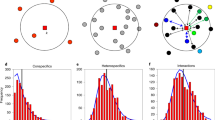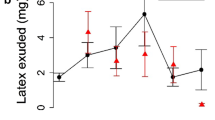Summary
We use Wiens' (1984) nonequilibrium-equilibrium continuum concept to evaluate aspects of community structure for sawfly herbivores (Hymenoptera: Tenthredinidae) that attack arroyo willow, Salix lasiolepis. The sawfly community on arroyo willow shares many characteristics of nonequilibrium communities: unsaturation, biotic decoupling, lack of density dependence, and loose emergent patterns. Species abundances exhibit highly significant differences among clones (P<0.001) and among years (P<0.001) and exhibit significant and complex clone-by-year interactions both for absolute and relative abundances. Organizing forces, such as interspecific competition and regulation by natural enemies, are largely absent from the arroyo willow system. Sawfly densities exhibit significant positive covariation among willow clones and appear to be affected by largely stochastic abiotic forces, primarily winter precipitation.
Similar content being viewed by others
References
Abbott I, Grant PR (1976) Nonequilibrial bird faunas on islands. Am Nat 110:507–528
Andrewartha HG, Birch LC (1954) The distribution and abundance of animals. University of Chicago Press, Chicago
Beaver RA (1977) Non-equilibrium island communites: Diptera breeding in dead snails. J Anim Ecol 46:783–798
Boecklen WJ, Price PW (1989) Size and shape of sawfly assemblages on arroyo willow. Ecology 70:1463–1471
Boecklen WJ, Price PW, Mopper S (1990) Sex and drugs and herbivores: sex-biased herbivory in arroyo willow (Salix lasiolepis). Ecology 71:581–588
Clancy KM, Price PW (1989) Effect of plant resistance, competition, and enemies on a leaf-galling sawfly (Hymenoptera: Tenthredinidae). Environ Entomol 18:284–290
Clancy KM, Price PW, Craig TP (1986) Life history and natural enemies of an undescribed sawfly near Pontania pacifica (Hymenoptera: Tenthredinidae) that forms leaf galls on arroyo willow, Salix lasiolepis. Ann Ent Soc Amer 79:884–892
Connell JH (1979) Tropical rain forests and coral reefs as open non-equilibrium systems. Symp Brit Ecol Soc 20:141–163
Connell JH (1983) On the prevalence and relative importance of interspecific competition: evidence from field experiments. Am Nat 122:661–696
Craig TP, Price PW, Itami JK (1986) Resource regulation by a stem-galling sawfly on the arroyo willow. Ecology 67:419–425
Craig TP, Price PW, Clancy KM, Waring GL, Sacchi CF (1988) Forces preventing coevolution in the three-trophic-level system: willow, a gall-forming herbivore and parasitoid. In: Spencer KC (ed) Chemical mediation of coevolution. Academic Press, New York, pp 57–80
Craig TP, Itami JK, Price PW (1989) A strong relationship between oviposition preference and larva performance in a shoot-galling sawfly. Ecology 70:1691–1699
Craig TP, Itami JK, Price PW (1990) The window of vulnerability of a shoot-galling sawfly to attack by a parasitoid. Ecology 71:1471–1482
Darroch JN, Mosimann JE (1985) Canonical and principal components of shape. Biometrika 72:241–252
Egerton FN (1976) Ecological studies and observations before 1900. In: Taylor BJ, White TJ (eds) Issues and ideas in America. University of Oklahoma Press, Norman, pp 311–351
Fritz RS, Price PW (1988) Genetic variation among plants and insect community structure: willows and sawflies. Ecology 69:845–856
Fritz RS, Sacchi CF, Price PW (1986) Competition versus host plant phenotype in species composition: willow sawflies. Ecology 67:1608–1618
Fritz RS, Gaud WS, Sacchi CF, Price PW (1987) Patterns of intrand interspecific association of gall-forming sawflies in relation to host shoot size on their willow plant. Oecologia 73:159–169
James FC, Boecklen WJ (1984) Interspecific morphological relationships and the densities of birds. In: Strong DR Jr., Simberloff D, Abele LG, Thistle AB (eds) Ecological communities: conceptual issues and the evidence. Princeton University Press, Princeton, New Jersey, pp 458–477
Kuhn TS (1970) The structure of scientific revolutions, 2 nd ed. University of Chicago Press, Chicago
Lawton JH (1982) Vacant niches and unsaturated communities: a comparison of bracken herbivores at sites on two continents. J Anim Ecol 51:573–595
Lawton JH (1984) Non-competitive populations, non-convergent communities, and vacant niches: the herbivores of bracken. In: Strong DR Jr., Simberloff D, Abele LG, Thistle AB (eds) Ecological communities: conceptual issues and the evidence. Princeton University Press, Princeton, New Jersey, pp 67–100
Lawton JH, Price PW (1979) Species richness of parasites on hosts: agromyzid flies on the British Umbelliferae. J Anim Ecol 48:619–637
McIntosh RP (1985) The background of ecology: concept and theory. Cambridge University Press, Cambridge
Mosimann JE, James FC (1979) New statistical methods for allometry with application to Florida Red-winged Blackbirds. Evolution 33:444–459
Preszler RW, Price PW (1988) Host quality and sawfly populations: a new approach to life table analysis. Ecology 69:2012–2020
Price PW (1977) General comments on the evolutionary biology of parasites. Evolution 31:405–420
Price PW (1980) Evolutionary biology of parasites. Princeton University Press, Princeton, New Jersey
Price PW (1984) Communities of specialists: vacant niches in ecological and evolutionary time. In: Strong DR Jr, Simberloff D, Abele LG, Thistle AB (eds) Ecological communities: conceptual issues and the evidence. Princeton University Press, Princeton, New Jersey, pp 510–523
Price PW (1987) Why does the bud-galling sawfly, Euura mucronata, attack long shoots. Oecologia 74:1–6
Price PW (1988) Inversely density-dependent parasitism: the role of plant refuges for hosts. J Anim Ecol 57:89–96
Price PW, Clancy KM (1986a) Multiple effects of precipitation on Salix lasiolepis and populations of the stem-galling sawfly, Euura lasiolepis. Ecol Res 1:1–14
Price PW, Clancy KM (1986b) Interactions among three trophic levels: gall size and parasitoid attack. Ecology 67:1593–1600
Price PW, Craig TM (1984) Life history, phenology, and survivorship of a stem-galling sawfly, Euura lasiolepis (Hymenoptera: Tenthredinidae), on the arroyo willow, Salix lasiolepis, in Northern Arizona. Ann Ent Soc Amer 77:712–719
Price PW, Roininen H, Tahvavainen J (1987) Plant age and attack by the bud galler, Euura mucronata. Oecologia 73:334–337
Sacchi CF, Price PW, Craig TM, Itami JK (1988) Impact of shoot galler attack on sexual reproduction in the arroyo willow. Ecology 69:2021–2030
Simberloff D (1980) A succession of paradigms in ecology: essentialism to materialism to probabilism. Synthese 43:3–39
Simberloff D (1983a) Competition theory, hypothesis testing, and other community ecology buzzwords. Amer Nat 122:626–636
Simberloff D (1983b) When is an island community in equilibrium? Science 220:1275–1277
Sousa WP (1979) Disturbance in marine intertidal boulder fields: the nonequilibrium maintenance of species diversity. Ecology 60:1225–1239
Stiling PD (1987) The frequency of density dependence in insect host-parasitoid systems. Ecology 68:844–856
Strong DR Jr. (1979) Biogeographic dynamics of insect host plant communities. Ann Rev Ecol Syst 24:89–119
Strong DR Jr. (1984) Exorcising the ghost of competition past: phytophagous insects. In: Strong DR Jr, Simberloff D, Abele LG, Thistle AB (eds) Ecological communities: conceptual issues and the evidence. Princeton University Press, Princeton, New Jersey, pp 28–41
Wiens JA (1984) On understanding a non-equilibrium world: myth and reality in community patterns and processes. In: Strong DR Jr., Simberloff D, Abele LG, Thistle AB (eds) Ecological communities: conceptual issues and the evidence. Princeton University Press, Princeton, New Jersey, pp 439–457
Wijk S (1986) Influence of climate and age on annual shoot increment in Salix herbacea. J Ecol 74:685–692
Author information
Authors and Affiliations
Rights and permissions
About this article
Cite this article
Boecklen, W.J., Price, P.W. Nonequilibrial community structure of sawflies on arroyo willow. Oecologia 85, 483–491 (1991). https://doi.org/10.1007/BF00323759
Received:
Accepted:
Issue Date:
DOI: https://doi.org/10.1007/BF00323759




